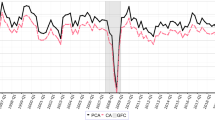Summary
This paper examines the cyclical relationship between exports and output in the U.K. using structural time-series modelling. The time series on exports and output over the period 1885–1993 are decomposed, and the cyclical components are extracted. Causality testing as applied to the cyclical components reveals the absence of causality from exports to output except in the post-1945 period. The results of causality testing are confirmed by the results of estimating a structural time-series model in which exports appear as an explanatory state variable. Three different explanations are suggested for the change in this relationship during the most recent period.
Similar content being viewed by others
References
Atukeren, E., 1994, ‘A Note on the Tests of Granger-causality Between Exports and Economic Growth,’Applied Economics Letters, 1, pp. 207–209.
Bahmani-Oskooee, M. and J. Alse, 1993, ‘Export Growth and Economic Growth: An Application to Cointegration and Error Correction Modeling,’Journal of Developing Areas, 27, pp. 535–542.
Beveridge, W., 1939, ‘Unemployment in the Trade Cycle,’Economic Journal, 49, pp. 52–65.
Britton, A., 1986,The Trade Cycle in Britain 1958–1982, Cambridge, Cambridge University Press.
Cappie, F.H. and T.C. Mills, 1991, ‘Money and Business Cycles in the U.S. and U.K., 1870 to 1913,’The Manchester School of Economic and Social Studies, 54 (supplement), pp. 38–56.
Chow, P.C.Y., 1987, ‘Causality Between Export Growth and Industrial Development: Empirical Evidence from NICs,’Journal of Development Economics, 26, pp. 55–63.
Corner, D.C., 1956, ‘Exports and the British Trade Cycle: 1929,’The Manchester School of Economic and Social Studies, 24, pp. 124–160.
Eichengreen, B.J., 1983, ‘The Causes of the British Economic Cycle, 1833–1913,’European Journal of Economic History, 12, pp. 145–161.
Godfrey, L.G., 1978, ‘Testing for Higher Order Serial Correlation in Regression Equations when the Regressors Include Lagged Dependent Variables,’Econometrica, 46, pp. 1303–1310.
Ford, A.G., 1969, ‘British Economic Fluctuations, 1870–1914,’The Manchester School of Economic and Social Studies, 37, pp. 99–130.
Gayer, A.D., W. Rostow and A.J. Schwartz, 1953,The Growth and Fluctuation of the British Economy, Oxford, Clarendon Press.
Harvey, A.C., 1985, ‘Trends and Cycles in Macroeconomic Time Series,’Journal of Business and Economic Statistics, 3, pp. 216–227.
Harvey, A.C., 1990,Forecasting, Structural Time-series Models and the Kalman Filter, Cambridge, Cambridge University Press (1990 reprint).
Hawtrey, R.G., 1913,Good and Bad Trade: An Enquiry into the Causes of Trade Fluctuations, London, Constable.
Hsiao, M.W., 1987, ‘Tests of Causality and Exogeneity Between Exports and Economic Growth: The Case of Asian NICs,’Journal of Economic Development, 12, pp. 143–159.
Jung, W.S. and P.J. Marshall, 1985, ‘Exports, Growth and Causality in Developing Countries,’Journal of Development Economics, 18, pp. 1–12.
Kugler, P., 1991, ‘Growth, Exports and Cointegration: An Empirical Investigation,’Weltwirtschaftliches Archiv, 127, pp. 73–82.
Liesner, T., 1989,One Hundred Years of Economic Statistics, London, The Economist Publications.
Ljung, G.M. and G.E.P. Box, 1978, ‘On a Measure of Lack of Fit in Time-series Models,’Biometrika, 65, pp. 297–303.
Matthews, R.C.O., 1959,The Trade Cycle, Cambridge, Cambridge University Press.
Ramsey, J.B., 1969, ‘Tests for Specification Errors in Classical Linear Least Squares Regression Analysis,’Journal of the Royal Statistical Society, B, 31, pp. 350–371.
Serletis, A., 1992, ‘Export Growth and Canadian Economic Development,’Journal of Development Economics, 38, pp. 133–145.
Sharma, S.C., M. Norris, and D.W. Cheung, 1991, ‘Exports and Economic Growth in Industrialised Countries,’Applied Economics, 23, pp. 697–708.
Walters, A.A., 1969,Money in Boom and Slump, Hobart Papers, No. 44, London, Institute of Economic Affairs.
Author information
Authors and Affiliations
Additional information
I would like to thank an anonymous referee for some useful comments. I am also grateful to Keshav Vishwakarma for his comments and to Lee Smith for her inquisitive reading of the paper
Rights and permissions
About this article
Cite this article
Moosa, I.A. The cyclical relationship between exports and output in the U.K.: 1885–1993. De Economist 144, 635–647 (1996). https://doi.org/10.1007/BF01371943
Issue Date:
DOI: https://doi.org/10.1007/BF01371943




